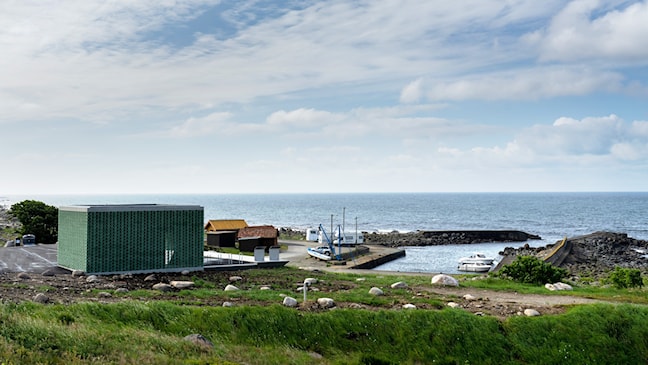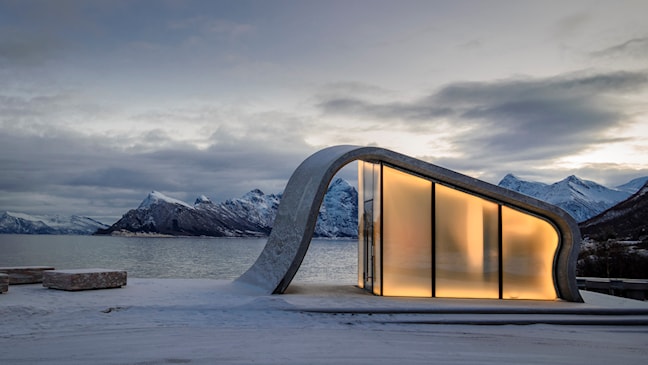Haugen/Zohar Arkitekter
Flesefossen
With a run-down toilets, outdated parking and old information boards, the rest area with a spectacular view towards Flesefossen was in need of an upgrade.
- Architect:
- Haugen/Zohar Arkitekter
- Finished:
- 2023

Inspired by Bratlandsdalåa, Flesefossen, water and glacial potholes, Haugen/ Zohar Arkitekter has designed a rest area with curvy lines that reflect the formations in the terrain.
The area is enhanced by a powerful structure with contrasting materials and colours. The steel structure, consisting of columns and a roof, undulates in line with the river flow and forms pockets with room for toilets and benches. The steel structure stands on a concrete plateau that defines the rest area and separates the main road and the waterfall. On the waterfall side, the plateau contains a viewing balcony and an amphitheatre where you can descend to the river.
The structure contains vertical wooden pillars of black-stained Accoya timber, forming denser sections with integrated functions. At the front is the car park with room for nine passenger cars and two buses, in addition to the entry and exit areas.
Madland harbour
Madland harbour is a beautiful place exposed to rough weather, located four nautical miles south of Obrestad.
- Architect:
- Haugen/Zohar Arkitekter
- Finished:
- 2023

The harbour is small with two protruding breakwaters and was built with government funding in the 1930s.
Today, the harbour is owned by the municipality. The old boathouses are privately owned, but tourists are welcome to fish, go for a walk or just take a break.
The Madland harbour project is divided into two parts and includes a new service building on a viewing plateau in front of a parking lot and a storm-watching cabin down by the sea.
The Lantern
The design of the viewing plateau was motivated by the characteristic Jæren light and the sea horizon. The plateau is a precise concrete surface in the landscape, reinforcing the experience of the boulders close by. From here, your eyes can follow the contours of the Jæren coast both northwards and southwards, with a high sky, a wide horizon and the endless sea.
On the plateau there is a new service building; the Lantern. The building consists of a glass core with toilets and an outer shell built up with green specially designed facade elements made of fiber-reinforced concrete. The way the facade elements have been shaped and combined lets the sunlight in and creates a fascinating interplay of light and shadow inside the service building. When it is dark, the light escapes through the elements and makes the building glow like a lantern in the harbour.
The storm-watching cabin
During winter storms, the harbour is a popular place for visitors who want to experience the extreme forces of nature up close. To provide a safe spot for viewers, a small storm-watching cabin has been built down by the harbour. The cabin is made from mass timber with a rhythmical glulam structure creating a spacial experience. The gable wall is of glass and offers a spectacular view. The cabin is meant to provide shelter for anyone travelling along Scenic Route Jæren.
Team
Architect: Haugen / Zohar Arkitekter AS
Landscape architect: Kristian Holo / Holo & Holo Landskapsarkitektur
Consultant for construction engineering: Ivana Katavic / Degree of freedom
Consultant for electrical engineering: Siw Sønvisen / Sweco
Consultant for heating, water and sanitary engineering: Jørgen Wilhelmsen / Sweco
Ureddplassen
Ureddplassen can be accessed from the east or from the west.
- Architect:
- Haugen/Zohar Arkitekter
- Landscape architect:
- Inge Dahlman - Asplan Viak
- Finished:
- 2018

Ureddplassen can be accessed from the east or from the west. If you come from the west, you will be looking towards the inner end of the fiord, at green mountain sides and rocky peaks. When you arrive from the east, you will have a wide view of the sea and the horizon.
Ureddplassen was already an established rest area with a war memorial to the sinking of the submarine “Uredd”. The rest area is also a popular destination among local residents and tourists alike, coming to see the midnight sun or the northern lights.
The new rest area has been furnished with a wide viewing terrace in concrete. A wide set of steps, alternately for walking and seating, leads down to the beach area. The view from the steps is expansive, and the seating is well protected from traffic noise. What is unique about the design is that all concrete elements have soft, rounded shapes instead of straight edges. The soft lines continue in a wave-shaped concrete toilet building framing the view towards the north. The walls are of glass that is lit in the dark. The terrace has been furnished with seating benches in the characteristic marble from Fauske. The base of the monument is made of the same material and is well placed.
The sevice building is designed ba Haugen/Zohar Arkitekter
The rest area is designed by Landskapsfabrikken AS - Inge Dahlman